Punjab State Board PSEB 10th Class Science Important Questions Chapter 15 Our Environment Important Questions and Answers.
PSEB 10th Class Science Important Questions Chapter 15 Our Environment
Long Answer Type Questions
Question 1.
Differentiate the following :
(i) Ecosystem and Biome
Answer:
| Ecosystem | Biome |
| 1. It is the self sustaining unit. | 1. It is the group of ecosystems. |
| 2, It is formed by living organisms and non living environment. | 2. It has ecosystems with almost same climate and specific geographical conditions. |
| 3. It is a comparatively small unit of the living world. | 3. It is a huge form of living world. |
(ii) Food Chain and Food Web
Answer:
Food Chain and Food Web
| Food Chain | Food Web |
| 1. It is a food and energy flow in an ecosystem that shows which organism is consumed by the other organism. | 1. It is a network of different inter connected food chains of an ecosystem. |
| 2. It is a systematic straight chain of getting food. | 2. It is a web composed by various interconnected food chains. |
| 3. There are a few number of trophic levels. | 3. There are large number of organisms in it that show natural balance in ecosystem. |
4. It is limited and small.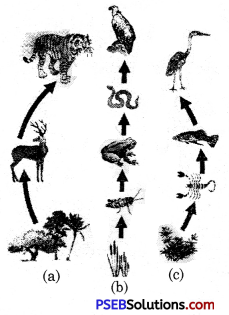 |
4. It is a web of many food chains.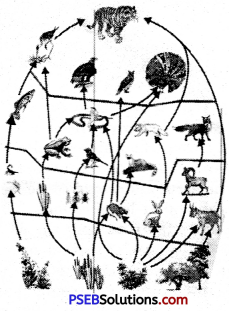 |
(iii) Carnivore and Omnivore
Answer:
Carnivore and Omnivore
| Carnivore | Omnivore |
| 1. These are flesh eating animals e.g. lion, cheetah, etc. | 1. These animals eat both flesh and plants e.g. human beings, eagle, etc. |
| 2. These are given place on 3rd trophic level or above. | 2. These are often given place on second trophic level. |
Question 2.
Why it is said that flow of energy is always unidirectional?
Answer:
Flow of energy is always unidirectional in this world. Flow of energy begins with the solar energy. Green plants get this energy with the help of photosynthesis. The energy of sun enters the organisms through environment. Only those plants and animals absorb sunlight in which a green pigment called chlorophyll is present. After absorbing this energy, plants change it into chemical energy which is stored in the form of carbohydrates. A part of it is utilized by the plants for their grow’th and development and the rest of energy is released in the form of heat.
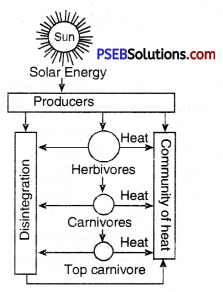
Trophic level
Herbivores eat these plants as their food. Chemical energy stored in food enters herbivores w’hen they eat these plants. Organisms spend some part of energy in their normal activities and development and some of its part in respiratory activities. A part of energy, which is not being used, is released as heat. Carnivores eat herbivores organisms and first cycle of energy begins. Energy which is not being used is released as heat. Energy released in the form of heat cannot be reused in the process of photosynthesis by plants. This is why the energy flow is called unidirectional.
![]()
Question 3.
Why does food chain become short?
Answer:
Energy flow’ is unidirectional and its transformation takes place at different levels. Energy is always transferred from lower level to the higher levels. Only 10% of the energy gets transferred ahvays when energy is transferred from one trophic level to the next. A lot of energy gets wrnsted if many transfers are present there in a food chain. Food chains should be small to save loss of energy.
Maximum energy is wasted if there are many trophic levels in a food chain. To save energy from getting wasted, food chain should be short. During energy transformation in food chain, maximum energy is present at producer level. Energy availability becomes low on moving towards right hand side in a food chain.
e.g. Grass → Grass Hopper → Frog → Snake → Peacock
If all frogs are killed in this chain, then it will be adversely affected. The following changes will be seen :
- Population of grass hoppers will increase.
- Population of snakes will decrease due to non-availability of frogs.
- Population of peacocks will be affected due to less number of snakes.
Due to unwanted and unnecessary deeds of human beings the food chain becomes small and that creates imbalance in nature.
Question 4.
Can there be more than six trophic levels in a food chain? If not, why?
Answer:
Energy transformation takes place at every level of a food chain and energy starts decreasing. After three or four levels, energy remains almost negligible. During photosynthesis plants absorb only 1% of solar energy and rest of the energy goes waste in environment. When herbivores consume plants, only 10% of energy is absorbed by them. If we assume that energy trapped by the sun provides 1000 J then plants absorb only 10 J and herbivores get 1 J from it. In the same way, when carnivores eat herbivores, they trap only 0.01 J of energy. Hence, when level of food chain increases, energy availability becomes low that is why it results in that a food chain cannot have more than six levels. The availability of energy is maximum at producer level and then keeps on decreasing and is least at last level.
Question 5.
In the context of energy which level of food chain is considered beneficial for us? Why?
Answer:
At producer level of food chain, maximum energy is available. It means that closer we are to producer level (plants) more energy we get. That is why in concept of energy, two or three level food chains are considered very beneficial.
Two level food chain : Producer → Human.
Green vegetables etc. are comparatively more beneficial. We get more energy from the vegeterian habits that’s why we get more energy by eating vegetables directly.
Third level food chain : Producer → Goat → Human. The energy which we get from this food chain is less because some amount of energy is absorbed by goat and some amount is released as heat energy and human beings get less amount of energy. This is why we say that second and third level food chains are beneficial for us.
Question 6.
Write in brief the role of decomposers in recycling.
Answer:
All the organisms on earth are differentiated as producers, consumers and decomposers on the basis of their food habits. Decomposers are the organisms which can carry out breakdown of complex organic compounds into simple compounds. They help in decaying dead bodies of plants and animals. These are parasites because simple compounds can also be absorbed by them through their body surface.
Plants absorb minerals from soil through water and carbon-dioxide from air is used in the process of photosynthesis. Major elements which participate in this process are C, N, O, S and P. These elements move to other tropic levels. These elements are released when dead bodies of the plants and animals are decayed with the help of decomposers. These elements can be absorbed by plants and they become a part of cycle again.
Question 7.
What is meant by soil erosion? What are agents of soil erosion? Write effects of soil erosion.
Answer:
Soil Erosion: It is the removal of top, fertile, mineral rich soil layer by water and wind.
Agents of Soil Erosion. The agents of soil erosion are water and wind, each contributing a significant amount of soil loss every year in our country. Soil erosion may be a slow process that continues relatively unnoticed or it may occur at an alarming rate causing serious loss of top soil.
Worldwide erosion removes about 25.4 billion tons of soil each year.
Effects of soil erosion. It has several adverse effects :
- Loss of productive land.
- Loss of crop/pasture.
- Reduced yield as fertilizers may also be washed out.
- It may damage roads, bridges, trees and houses.
Short Answer Type Questions
Question 1.
Define environment. What are its major components?
Answer:
The immediate surroundings where we live is called our environment. The major components of it are biotic and abiotic.
Biotic components: All living organisms, plants and human beings are considered in biotic components.
Abiotic components: Physical or non-living components include air, water, soil. Air is used for respiration, water is used for drinking and soil (land) where we live. Apart from this there are climatic components like solar energy, heat, light, rain, humidity, air, etc.
Question 2.
What is environmental pollution? Write three examples of non- hiodegradables which are harmful for human beings.
Answer:
Environment is mainly comprised of physical and living components. Any unsuitable change in the natural conditions of these components is called pollution. Environmental pollution is mainly of three types—water pollution, soil pollution, air pollution.
Water pollution is mainly caused due to inorganic waste from various industries. This dirty liquid waste is made to flow in rivers which leads to pollution of river water. Various chemicals used in agricultural lands, excreation in open garbage, dead bodies, etc. are the main causes of soil pollution. Excess percentage of oxygen in air has no ill effect on air but the change in quantity of other gases in air makes it unfit for respiration. This is called air pollution. Decomposition of non-biodegradable substances is very slow and their life is long. e.g. DDT, compounds of arsenic, etc.
Question 3.
How does development affect our environment?
Answer:
Excessive developments always effects our environment. Imbalance in environment is the result of development made by we people. To meet the increasing needs and demands resources are always tapped. For this, we have to depend on environment. Our natural resources are limited. And their unjudicious use gives an adverse effect on environment. Environment gets polluted when land suitable for agriculture is used for making hotels and buildings. In this way development affects our environment.
Question 4.
Define Pollution.
Answer:
The appearance of unwanted and harmful changes in our biological, physical and chemical environment is called pollution. Mainly pollution is of three types—soil, air and water pollution.
Question 5.
Differentiate biodegradable and non-biodegradable pollutants. Classify the following under the above two categories : DDT, Paper, Cotton cloth, Plastics.
Answer:
| Biodegradable pollutants | Non-biodegradable pollutants |
| 1. These pollutants can be broken down into non poisonous substances in nature by the action of living organisms such as bacteria, fungi. | 1. These pollutants cannot be broken down into non poisonous substances by living organisms. |
| 2. They get recycled thus do not need any dumping sites. | 2. They cannot be recycled thus require dumping sites. |
| 3. They cause minimum environmental pollution. Example : Paper and cotton cloth. | 3. They cause environmental pollution. Example : DDT and plastics. |
Question 7.
Define Biosphere.
Answer:
Biosphere means: ‘Sphere of living beings’. Land, water and air are present on earth. These help plants and animals to live. All these three combine together as a unit to help the survival of life on earth. It is the largest biological system and is called biosphere.
Question 8.
What happens when we add waste to the environment? Explain.
Answer:
Problems caused by the wastes
- Solid waste is a great environmental hazard.
- Plastic and their waste products such as carry bags, waste glasses, bottles, cups, plates are most dangerous as they choke in drain.
- They cause soil pollution and degrade the soil.
- They prevent growth of vegetation when dumped underground.
- Water pollution will make the water non-potable.
- The plastic waste when mixed with municipal waste make them unfit for recycling.
- Non-biodegradable substances may be inert and simply persist in the environment for a long time and may harm various members of the ecosystem.
Question 9.
List the biotic and abiotic components of ecosystem.
Answer:
Differences between Biotic and Abiotic components of ecosystem
Biotic Components:
- Biotic components of an ecosystem are those living substances which are different members of a community.
- Biotic components of an ecosystem are :
- Producers
- Consumers
- Decomposers
Abiotic Components
- Abiotic components are non-living factors.
- It includes water, minerals, salts, humidity, light, temperature, pH, wind, topography and background.
Question 8.
Explain functions of ecosystem.
Answer:
Functions of ecosystem
- Energy flow: The energy flow from producers to consumers. There is loss of energy at every trophic level.
- Biogeochemical cycle: The cyclic flow of nutrients between non-living environment and living organisms is called biogeochemical cycles.
![]()
Question 9.
List the key functional aspects of ecosystems.
Answer:
- Productivity and energy flow.
- Nutrient cycling.
- Development and stabilization.
Question 10.
Differentiate between producers and consumers.
Answer:
| Producers | Consumers |
| 1. The organisms which can prepare their own food by the process of photosynthesis are called producers. | 1. The organisms which are dependent on other organisms for their food are called consumers. |
| 2. Green plants are called producers. | 2. All animals are called consumers. |
Question 11.
How different levels will be affected if frogs are removed from the following food chain?
Grass → Grass Hopper → Frog → Snake → Peacock
Answer:
- Number of grass hoppers will increase on removing frogs.
- Grass will decrease due to increase in population of grass hoppers.
- Due to less grass, there wall be struggle between grass hoppers for their survival.
- Due to non-availability of frogs, snakes and peacocks will start consuming some different food for their survival.
- Snakes and peacocks may change their place for getting their food.
Question 12.
Write food chains of various trophic levels. At which level energy will be maximum?
Answer:
Examples of food chain are :
- Plants → human
- Grass → deer → snake
- Grass → insects → frog → snake
- Alga → small organism → small fish → large fish
- Grass → grass hopper → frog → snake → peacock.
In these food chains, first level is always of producers.
In these food chains :
1st is two-level, 2nd is three-level, 3rd and 4th are four-level and 5th is five-level food chain.
Question 13.
How does energy reach from environment to the consumer and in which form?
Answer:
Plants have green pigment in them called chlorophyll due to which they can trap solar energy. Energy from environment enters through photosynthesis. 1% of sunlight is used by the plants through photosynthesis. Plants change this energy to chemical energy and is stored in the form of carbohydrates. A part of this energy is used in respiration by the plants which helps in their growth and development. Chemical energy stored in the eatable goes to the first trophic level (herbivores) and is used for respiration and growth.
Question 14.
What will happen if all the decomposers are removed from the ecosys¬tem?
Answer:
If the decomposers are removed from the ecosystem :
- Complex organic matter will not be broken. So nutrients will not return to nutrient pool.
- Different nutrient cycles will be disturbed.
- Balance in the eco-system will be disturbed.
- Waste materials will get accumulated.
Question 15.
Write four characteristics of food web.
Or
What is food web?
Answer:
Characteristics of Food Web
- Unlike food chains, food webs are never straight.
- Food web is formed by inter-linking of food chains.
- Food web helps in ecosystem development.
- Food web provides alternative pathways of food availability. Example, if a particular species of producers is destroyed by a disease in the ecosystem the herbivores of that area can feed on other species of producers.
Question 16.
What results do you get from the transformation of energy?
Answer:
Energy transformation takes place from producer to consumer in a food chain. Following results are found from this transformation :
- Energy is changed from one form to the other. During photosynthesis light energy changes to chemical energy. Only plants can transform energy from one form to another. This is why they are called as transformers.
- Energy level during transformation continuously decreases from one trophic level to the other trophic level. Some part of energy is utilised by these for their growth and the remaining is released in the form of heat.
- The energy available at any trophic level becomes less than the energy at producer level.
Question 17.
How do harmful insecticides concentrate in our bodies?
Answer:
Many pesticides are sprayed on crops to protect them from various pests and diseases. These chemicals get dissolved in water and by dripping through soil reach the underground water level. Plants absorb these with other minerals in the form of water received from the soil. In this way, they enter our food chain. During transformation of energy at different levels of food chain, these chemicals get concentrated in our bodies.

These harmful chemicals are found in large amount in human bodies. Concentration of DDT is maximum in our bodies which is used as insecticide to kill mosquitoes.
Question 18.
How are human beings responsible for ecological imbalance?
Answer:
Various modern agricultural techniques are used by man which are responsible for ecological imbalance because of the following reasons :
- Use of machinery and other impliments.
- Use of fertilizers and harmful medicines.
- Burning animal dung and other things.
- Deep Mining.
Question 19.
(i) What is 10% law?
Answer:
According to this law only 10% of energy is transferred to the organisms of next trophic level from the previous one.
(ii) Which man will get more energy-vegetarian or meat eater? Give reason.
Answer:
By energy concept, herbivores are more benefitted.
Reason: Plants are at first trophic level. 10% of the energy is transferred to next level which clears that herbivores (vegetarians) get more energy as compared to carnivores (meat eaters).
Question 20.
Explain with the help of a diagram how is life on earth dependent on sun?
Answer:
In biosphere various organisms live and all these are dependent on sun for their various activities. Sun is the basic and ultimate source of energy. Solar energy enters the biosphere through photosynthesis.
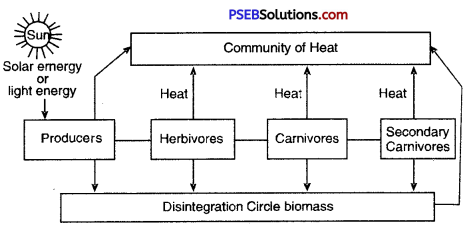
Life on Earth is dependent upon Sun.
Question 21.
How is ecological balance maintained?
Answer:
Food chains are connected in nature. Sometimes, a level of food chain comes to an end. Then that food chain connects itself to some other level of the food chains and stability remains maintained. The flow of food material and energy remains intact. If all deers living in a forest are destroyed, then lion will start killing some other animal as it’s alternative and will complete the cycle. Ecological balance is thus maintained by nature.
Question 22.
Name the chemicals which are considered responsible for hole in ozone layer.
Answer:
- Aerosols
- Modern fire extinguishers
- Nuclear Explosion
- Halogen
- Sulphate aerosol
- CFCs, (Chlorofluoro carbons), CBC (Chlorobromo carbons) etc. which are used in refrigeration.
![]()
Question 23.
Name the activities of human beings those have caused much harm to environment.
Answer:
- Rapidly increasing population
- Industrialisation
- Excessive use of fertilizers and pesticides
- Deforestation
- Mining of mountains
- Excess use of fossil fuels
- Misuse of fertile agricultural land
- Unplanned and uncontrolled expansion of cities.
Question 24.
Name the problems created by human beings for whole of the world.
Answer:
- Depletion of ozone layer
- Acid rain
- Rapid changes in environment
- Natural disasters-Land slides, Floods
- Mountain Slide
- Green house effect
- Irregular rainfall
- Increase in Cancer, Heart diseases etc.
- Drought and expansion of deserts.
Question 25.
Distinguish between decomposers and parasites.
Answer:
| Decomposers | Parasites. |
| 1. These are often not harmful for living beings. | 1. These cause harm to living beings. |
| 2. These change complex carbonic material to simple carbon matter and absorb them. Example: Mushroom. | 2. These get their food from the bodies of other living beings. Example: Ascaris, Taenea. |
Question 26.
A food chain is given below :
Grass → Deer → Lion
What will happen if lion is removed from this food chain?
Answer:
If all lions are removed from this food chain the growth of deer will become uncontrolled and their number will increase very rapidly. They will graze the grass to its extinction and that area will change into a desert.
Question 27.
Think about the food chains given below :
(I) Plants → Rats → Snakes → Hawks
(II) Plants → Rats → Hawks
If in these two food chains 100 joule of energy is present in both at the producer level, write from which food chain will hawk get more energy and how much? Justify your answer.
Answer:
Hawks will get more energy from three steps food chain because hawks are comparatively nearer to the plants. According to 10% law, energy available to next level is 10% of the energy transferred from the previous level. Hawks will get more energy in second food chain and that will be (10 – 01) joule excess.
Question 28.
Explain with the help of a food chain how does bio-magnification of harmful chemicals take place.
Answer:
The entry of harmful chemicals in our food chain with the help of various methods and its continuous accumulation and concentration is called bio-magnification.
These chemicals can enter our bodies by many means. Suppose 0 02 ppm insecticide was there in water of a lake. 5 ppm of it got concentrated in phytoplankton and 240 ppm in fish. Consumed 1600 ppm insecticide was accumulated in those birds who consumed these fishes. It clearly shows that bio-magnification increases with the increase in food chain.

Question 29.
If plants get 20,000 J of energy from sun, how much energy will be available to lion in the following food chain? Calculate.
Plants → Deer → Lion
Answer:
We know that 10% energy flow takes from one trophic level to the other.
∴ Lion will get only 20 J of energy.
Question 30.
Why do the food habits of first and third tropic levels differ?
Answer:
First trophic level is a result of producers. All green plants are related to first trophic level. They are autotrophs whereas third trophic level is of carnivores. They are second level consumers.

Question 31.
How much joules of energy will be received by vulture in the chain of three living beings—vulture, snakes and paddy. Sun provides 10,000 J energy to Paddy.
Answer:
Food chain
Wheat → Mouse → Snake → Vulture

According to 10% law, only 10% of energy will be available to next level. That’s why vulture will get 10 J of energy.
Question 32.
How does ecological pyramid represents the graphical representation of food system of living being in biosphere?
Answer:
Ecological pyramid shows the graphical representation of food chain and its various trophic levels. Ecological pyramid shows different trophic levels in such a way that base of it is shown by producer. As we move from base to upper direction the higher trophic levels are seen. The peak of pyramid is shown by extreme carnivores.
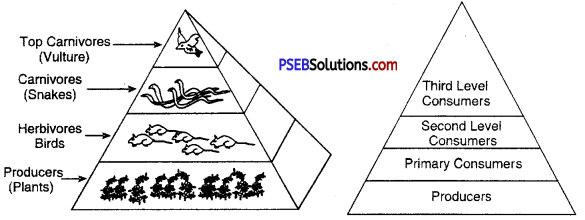
Ecological pyramid of food system in living beings
Question 33.
How is ozone made in atmosphere? How is it depleting?
Answer:
O3 molecule is a result of combining three atoms of oxygen. The oxygen molecule has two atoms of oxygen. Oxygen is necessary for respiration of organisms. But ozone is deadly poisonous in nature. At higher levels of atmosphere ozone performs a vital role. It protects earth from ultra violet radiations coming from sun towards earth. U.V. radiations are extremely harmful for all organisms on earth. These radiations causes skin cancer. On the higher level of air U.V. radiations disintegrate O2 and produces free oxygen (O). The free atom of oxygen (O) combines with oxygen that results in the formation of ozone (O3).

Question 34.
In railway trains, tea/coffee is served in earthen pots and disposal cups made of paper? What are the harms of it?
Answer:
Tea/Coffee is served in railway trains just because of two reasons-cleanliness and convenience. But soil of fertile lands is used for making these cups which is very harmful for the fertility of agricultural lands. Also disposal paper cups are made of paper which is made of wood. It is very difficult to recycle these. It will increase the process of deforestation. These cups also cause pollution.
Our environment will get disturbed because of this.
Question 35.
What is ozone hole? What is its significance?
Answer:
Ozone hole: It means a complete disappearance of ozone layer over a part of atmosphere. During the period 1956-1970 the spring time 03 layer thickness above Antarctica varied from 280-325 Dobson unit. Thickness was sharply reduced to 225 DU in 1979 and 136 DU in 1985. The decline in ozone layer thickness is called ozone hole. It was first noted in 1985 over Antarctica.
Cooling of the stratosphere (where ozonosphere is located) will produce bigger ozone hole not only over Antarctica but also over Arctic region. Ozone layer will further thin out
from rest of the stratosphere. It will be accompanied by major climatic changes all over the globe. Forests will be wiped out from many places. Radio communications will be disrupted.
Question 36.
Write the harmful effects of ozone depletion.
Answer:
Effects of ozone depletion
- UV radiation striking the earth and these radiations cause skin cancer and damage to eye.
- These damage defence (immune) system of body.
- May lead to variations in global rainfall.
- It causes ecological disturbances such as floods, shortage of food etc.
Question 37.
Explain global warming.
Answer:
Global Warming or Greenhouse Effect: Carbon dioxide content of the air is increasing due to deforestation and combustion in industries, automobiles and planes, and is likely to become double by 2020. This increase is affecting the atmospheric composition and balance gases, which are among the factors that control earth’s climate.
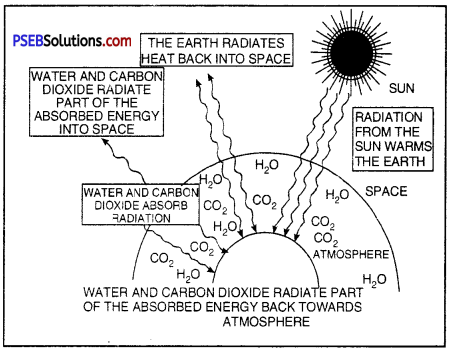
Green house
Increase of carbon dioxide may cause rise in atmospheric temperature, producing what is called the greenhouse effect. A rise of global temperature by more than 2 or 3 degrees may melt glaciers and polar ice. This will cause rise in ocean level and consequent flooding of coastal towns and submission of islands. Rainfall pattern may also change, affecting agricultural output.
Question 38.
How is acid rain formed? Effect
Answer:
Acid rain: When S02 and S03 produced from incomplete combustion of fossil fuel and smelting of non-ferrous metals combine with water, form H2S03 and H2S04. They fall down in the form of rain, it is called acid rain.
Question 39.
What is global warming?
Answer:
The increase in global temperature due to rise in amount of C02 concentration in the atmosphere.
![]()
Question 40.
List four common disposal methods.
Answer:
- Incineration: Reduction to ashes.
- Recycling: Recovery and processing to be used again.
- Composting: Converting into compost to be used as manure.
- Landfill: Bury the waste in low lying area.
Question 41.
Complete the sketch by labelling A, B, C, D to illustrate food web.
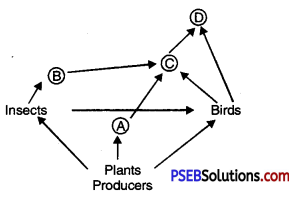
Food Web
Answer:
Food web:
(A) Rats
(B) Frog
(C) Snake
(D) Vulture.
Question 42
Match the following :
| Column I | Column II |
| (a) Phyto planktons | (i) Fish |
| (b) Larvae/Insects | (ii) Bird |
| (c) Carnivore | (iii) Primary Consumers |
| (d) Top Carnivore | (iv) Producers. |
Answer:
| Column I | Column II |
| (a) Phyto planktons | (iv) Producers. |
| (b) Larvae/Insects | (iii) Primary Consumers |
| (c) Carnivore | (iii) Primary Consumers |
| (d) Top Carnivore | (ii) Bird |
Very Short Answer Type Questions
Question 1.
What do you mean by the word environment?
Answer:
Environment is the sum total of all external conditions and influences that affect the life and development of an organism i.e. the environment includes all physical or abiotic and biological or biotic factors.
Question 2.
Where do different countries discuss their problem based on environmental issues?
Answer:
Developed and developing countries discuss their issues regarding environmental problems in world conferences regularly.
Question 3.
In whi ch biogeochemical cycles do various interactions take place?
Answer:
Nitrogen, carbon, oxygen and water cycles.
Question 4.
Which substances are called waste substafices?
Answer:
Substances which become unuseful and remain of no worth for us are called waste substances.
Question 5.
What helps in digestion of food in our body?
Answer:
Enzymes.
Question 6.
Which substances are specific in their action?
Answer:
Enzymes.
Question 7.
Which man made material cannot be decomposed by bacteria and decomposers?
Answer:
Plastic.
Question 8.
Which physical conditions affect plastic?
Answer:
Heat and Pressure.
Question 9.
What are biodegradable sub-stances?
Answer:
The substances which get decomposed in their life cycle by decomposers are bio-degradable substances.
Question 10.
Give four examples of biodegrad-able substances.
Answer:
Peals of fruits and vegetables, paper, fodder, husk.
Question 11.
What are non-biodegradable substances?
Answer:
Those substances which cannot be decomposed throughout their life by the decomposers are called non-biodegradable substances.
Question 12.
Give two examples of non-biodegradable substances.
Answer:
Plastic, Glass.
![]()
Question 13.
Give examples of natural ecosystem.
Answer:
Forest, ponds, lakes.
Question 14.
Give two examples of man made ecosystem.
Answer:
Garden, Agricultural field.
Question 15.
In which three categories are the organisms categorised?
Answer:
Producers, consumers and decomposers.
Question 16.
What are Producers?
Answer:
The organisms those convert inorganic substances into organic substance during photosynthesis with the help of sunlight and chlorophyll are called producers.
Question 17.
Give two examples of organisms which can do photo-synthesis.
Answer:
Green plants and blue green algae.
Question 18.
On what do all organisms directly or indirectly dependent for their food?
Answer:
Producers which means plants undergoing photosynthesis.
Question 19.
What are consumers?
Answer:
The organisms which depend directly or indirectly on producers for food are called consumers.
Question 20.
Give four examples of consumers.
Answer:
Human beings, Lion, Monkey, Sparrow.
Question 21.
Which two organisms decompose waste substances?
Answer:
Microbes and Fungi.
Question 22.
Why are micro-organisms called decomposers?
Answer:
Micro-organisms convert complex organic substances into simple inorganic substances which mix with the soil and are again used by plants.
Question 23.
Where are living organisms found?
Answer:
They are found in sea water, ice-covered regions, air and soil.
Question 24.
What is biosphere?
Answer:
All environmental regions found on earth and the organisms living there together form biosphere.
Question 25.
List four components which help in making biosphere a non-living component.
Answer:
Air, water, soil and minerals are non-living components of biosphere.
Question 26.
Do living and non-living components dependent on each other?
Answer:
Yes, they are dependent on each other and affect each other also.
Question 27.
List the living components of biosphere.
Answer:
Plants and organisms.
Question 28.
What is the main activity of decomposers?
Answer:
The micro-organisms decompose the dead remains of plants and animals. This category comprises microbes and fungi.
Question 29.
Give one example each of autotrophs and heterotrophs.
Answer:
Autotrophs—Green plants Heterotrophs—Human beings.
Question 30.
Is energy increased or decreased during transformation in food chain?
Answer:
Energy is decreased at every coming trophic level.
Question 31.
Grass → deer → lion.
Who is the producer and why?
Answer:
Grass is the producer because it traps sunlight to store food in form of carbohydrates.
![]()
Question 32.
What are omnivores?
Answer:
Organisms which eat both plants and flesh of other animals are called omnivores, e.g. Man.
Question 33.
Name two ecosystems of this world.
Answer:
Forests and oceans.
Question 34.
Grass → insects → frog → birds → human.
In this food chain (i) Who gets maximum energy? (ii) Who gets minimum energy?
Answer:
Insects get maximum energy and human beings get least energy.
Question 35.
Give an example of food chain in water.
Answer:
Algae → small organisms → small fish → large fish.
Question 36.
What is formed when various food chains combine?
Answer:
Food web.
Question 37.
Who will get more energy-herbivores or carnivores?
Answer:
Herbivores.
Question 38.
What is the main activity of food chain?
Answer:
Transformation of food and energy are main activities of food chain.
Question 39.
What are planktons?
Answer:
Planktons are extremely small micro-organisms which float independently in ponds, sea, rivers, etc.
Question 40.
What are phytoplanktons?
Answer:
Phytoplanktons are producers those can easily float on the surface of water.
Question 41.
What are zooplanktons?
Answer:
These are very small living beings which feed on phytoplanktons e.g. Amoeba, Paramecium etc.
Question 42.
Which organisms produce food material?
Answer:
Green plants are the producers
Question 43.
Give an example of a producer of water food chain.
Answer:
Algae.
Question 44.
How is energy transferred?
Answer:
Energy enters through abiotic components and is released in the from of heat.
Question 45.
How are eagle and vultures important components of our environment?
Answer:
Eagle and vultures live by eating dead bodies of animals so they play a vital role in food chains.
Question 46.
What are trophic levels?
Answer:
The levels at which food is transferred in a food chain is called trophic levels.
Question 47.
Who forms food chain?
Answer:
Organisms participating at different levels of this chain, form the food chain.
Question 48.
What form trophic levels?
Answer:
Each level of a food chain forms a trophic level.
Question 49.
Who are related to first trophic level?
Answer:
Autotrophs or producers.
Question 50.
Who are the organisms of second trophic level?
Answer:
Herbivores or first level consumers.
Question 51.
Give two examples of third trophic level organisms.
Answer:
Lion, Cheetah (Jaguar).
Question 52.
How much amount of solar energy is trapped by green plants?
Answer:
10%.
Question 53.
How much percentage of food can be transferred to next trophic level?
Answer:
10%.
Question 54.
How many levels are there in normal food chain?
Answer:
Three or four levels.
Question 55.
At which level is the population maximum?
Answer:
Producer level.
Question 56.
In whose body of some living being is the most toxic chemical accumulated?
Answer:
Human’s body.
Question 57.
What is the reason of accumulation of the most harmful substances in human’s body?
Answer:
Biological magnification.
Question 58.
How many atoms of oxygen combine to form ozone?
Answer:
Three atoms.
Question 59.
From what does ozone layer protect earth?
Answer:
From U.V. radiations.
Question 60.
What harm can be caused to human beings by U.V. radiations?
Answer:
It causes skin cancer.
Question 61.
What decomposes atoms of oxygen (02) to free oxygen (O) at the higher level of air?
Answer:
U.V. radiations of higher energy.
Question 62.
Since when the level of ozone has started decreasing in atmosphere?
Answer:
Since 1980.
Question 63.
What is the root cause of depletion of ozone layer?
Answer:
Chlorofluorocarbons (CFC’s).
![]()
Question 64.
Where are CFC’s mainly used?
Answer:
In refrigeraters and fire extinguishers.
Question 65.
What agreement was accepted by United Nations Environment Programme (UNEP) in 1987?
Answer:
Agreement to freeze CFC production at 1986 levels.
Question 66.
How improvement in our life style has affect garbage?
Answer:
Garbage has increased.
Question 67.
Which type of garbage has increased with the change in packaging material?
Answer:
Non-biodegradable waste has increased.
Question 68.
Name any two water pollutants.
Answer:
- Domestic sewage.
- Industrial effluents.
Multiple Choice Questions
Question 1.
Biotic components include:
(A) producers only
(B) consumers only
(C) producers and consumers only
(D) producers, consumers and decomposers.
Answer:
(D) producers, consumers and decomposers.
Question 2.
The word ecosystem was coined by:
(A) Writer
(B) Tansley
(C) Odum
(D) Darwin.
Answer:
(B) Tansley
Question 3.
Green plants are:
(A) autotrophs
(B) heterotrophs
(C) parasites
(D) saprophytes.
Answer:
(A) autotrophs
Question 4.
Which organism Is a decomposer?
(A) Vukure
(B) Fungus
(C) Fox
(D) Frog.
Answer:
(B) Fungus
Question 5.
Grass-insect-frog-snake-hawk. In this food chain the secondary consumers are:
(A) insects
(B) frog
(C) snake
(D) grass.
Answer:
(B) frog
![]()
Question 6.
Which one is a primary consumer in a pond ecosystem?
(A) Green algae
(B) Zooplankton
(C) Snake
(D) Bacteria.
Answer:
(B) Zooplankton
Question 7.
The best arrangement of an energy system consisting of hawks, snakes, mice and grasses is:
(A) grass → mice → snake → hawks
(B) grass → snake → mice → hawks
(C) grass → mice — hawks → snakes
(D) mice → snake → hawks → grass.
Answer:
(A) grass → mice → snake → hawks
Question 8.
They can be put in the category of primary consumers:
(A) Eagles and tigers
(B) Fishes and whales
(C) Snakes and frogs
(D) Insects and cattles.
Answer:
(D) Insects and cattles.
Fill in the Blanks:
Question 1.
_________ and _________ are examples of non-biodegradables wastes.
Answer:
Plastics, metal.
Question 2.
_________ and _________ are examples of artificial ecosystem.
Answer:
Crop field, aquarium.
Question 3.
Plants prepare their own food by trapping solar energy and are called _________
Answer:
Producers.
Question 4.
_________ is a unit of environment and can be identified and studied.
Answer:
Ecosystem.
Question 5.
Each step in a food chain constitute _________
Answer:
Trophic level.
![]()
Question 6.
Thinning in ozone layer allows harmful _________ rays to reach earth surface.
Answer:
UV.
Question 7.
Burning of waste in low lying area is called _________
Answer:
Land fill.